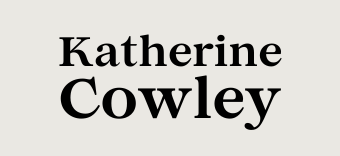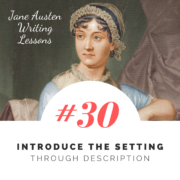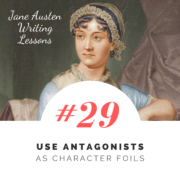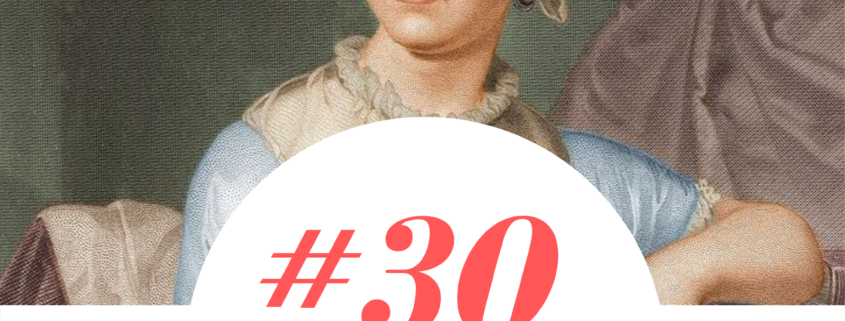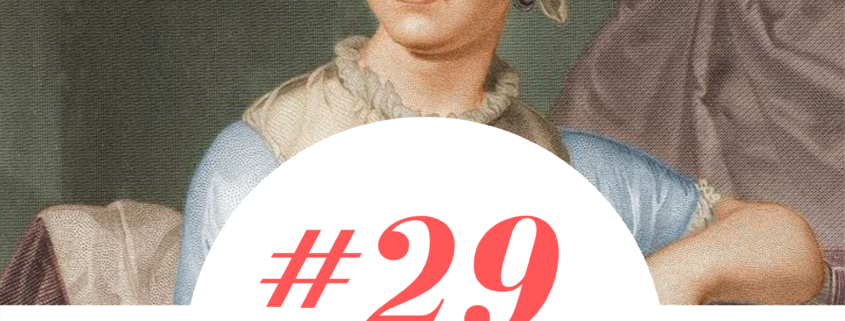Full Sized Blog Element (Big Preview Pic)
#30: Introduce the Setting through Description
/0 Comments/in Jane Austen Writing Lessons/by Katherine Cowley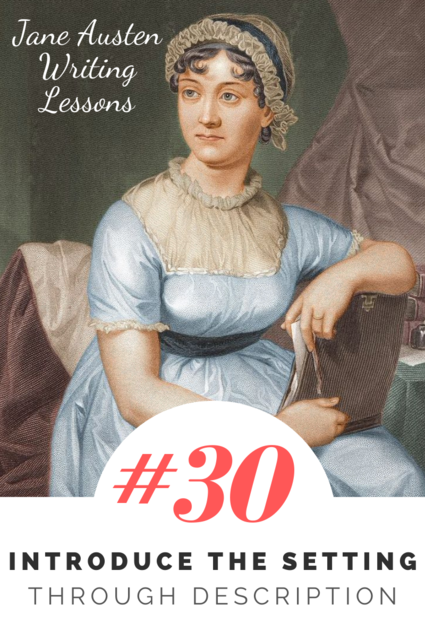
When I was in grad school, I studied Rhetoric and Composition (the teaching of writing). In a class I took which incorporated classical rhetoric, I wrote an essay about the Latin term descriptio, or what today we would call description. According to the website Silva Rhetoricae, description is “a composition bringing the subject clearly before the eyes.” In other words, it helps us visualize something on the page.
The Greeks and the Romans considered descriptio (description) to be the opposite of narratio (narrative).
Description≠Narrative
Narrative is about forward movement, it’s about story and progression, it’s about events happening. But anytime you have description, it halts the forward movement: we are now looking at something being painted before our eyes. And that painting takes time.
This is not to say that all description should be avoiding, but it is essential to realize as a writer that description competes with narrative.
Jane Austen, as always, is an excellent role model on how to use description, particularly in how she describes her settings. She gives enough detail to give us a sense and feel of the whole without disrupting the forward movement of the narrative.
In a previous post, I talked about the importance of using setting to influence plot and character. In this post, we’re going to look at a few passages from Elizabeth’s physical journeys in Pride and Prejudice to see how Jane Austen uses description to establish setting. In the process, I’ll talk about five specific techniques that she uses to powerfully introduce setting through description.
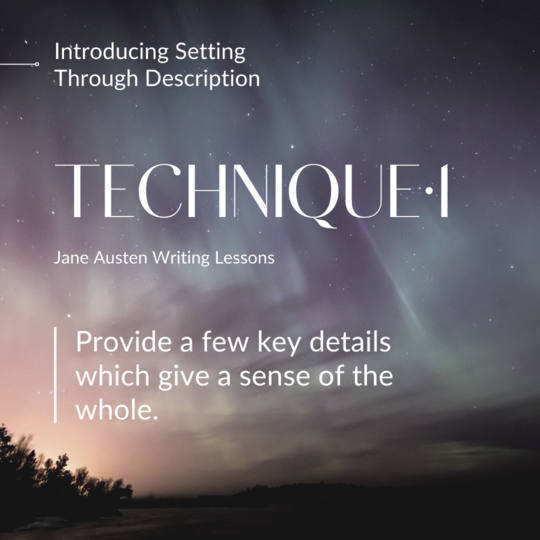
Technique 1: Provide a few key details which give a sense of the whole.
One of Austen’s primary techniques in establishing setting is to only use a few pertinent details. Unlike a production designer in a film, who must physically choose, create, acquire, and place every single item which we see, a novelist is generally best served by focusing on a few points that give a taste, a feel, or a sense of the whole.
In Pride and Prejudice, Elizabeth’s first trip away from home is to visit her friend Charlotte Collins née Lucas. After Elizabeth turned downed Mr. Collins’ offer of marriage, her friend Charlotte accepted his hand, and now, at Charlotte’s behest, Elizabeth has come to visit the parsonage where they live.
In the following two passages from when Elizabeth arrives, note how we are given only a smattering of concrete descriptive details, yet from this we understand not just the setting, but the people who are part of it.
Passage 1 (emphasis added):
Elizabeth was prepared to see [Mr. Collins] in his glory; and she could not help fancying that in displaying the good proportion of the room, its aspect and its furniture, he addressed himself particularly to her, as if wishing to make her feel what she had lost in refusing him….After sitting long enough to admire every article of furniture in the room, from the sideboard to the fender…Mr. Collins invited them to take a stroll in the garden, which was large and well laid out, and to the cultivation of which he attended himself.
The sideboard and the fender stand in for all of the furniture, the rest of which we are meant to conjecture. For the garden we receive only two details: it is large and it is well laid out. More concrete particulars are not relevant.
Passage 2 (emphasis added):
Charlotte took her sister and friend [Elizabeth] over the house, extremely well pleased, probably, to have the opportunity of shewing it without her husband’s help. It was rather small, but well built and convenient; and everything was fitted up and arranged with a neatness and consistency of which Elizabeth gave Charlotte all the credit. When Mr. Collins could be forgotten, there was really a great air of comfort throughout, and by Charlotte’s evident enjoyment of it, Elizabeth supposed he must be often forgotten.
In this passage, Austen swiftly paints a picture of the house, giving not just concrete details, but also value judgments (neatness and consistency are a good thing, and reflect positively on Charlotte) and a more general, abstract sense of the feel (“a great air of comfort throughout”).
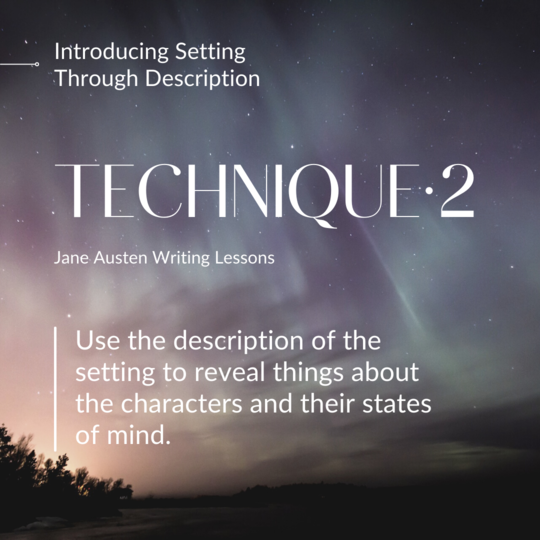
Technique 2: Use the description of the setting to reveal things about the characters and their states of mind.
On its most basic level, describing a setting is useful because it orients the reader—we feel grounded when we know where we are and what’s going on. Yet Austen never just uses setting description to orient us: she always makes it serve double-duty.
A good description reveals as much about characters and their states of mind as it reveals about the setting itself.
Mr. Collins’ parsonage abuts Rosings, the grand estate belong to his esteemed patroness, Lady Catherine de Bourgh.
They are invited to dinner, and they all walk together to approach Rosings. In the following description of setting, notice what is revealed about Elizabeth, and about Charlotte’s sister Maria and father Sir William:
Every park has it beauty and its prospects; and Elizabeth saw much to be pleased with, though she could not be in such raptures as Mr. Collins expected the scene to inspire, and was but slightly affected by his enumeration of the windows in front of the house, and his relation of what the glazing altogether had originally cost Sir Lewis De Bourgh.
When they ascended the steps to the hall, Maria’s alarm was every moment increasing, and even Sir William did not look perfectly calm.—Elizabeth’s courage did not fail her. She had heard nothing of Lady Catherine that spoke her awful from any extraordinary talents or miraculous virtue, and the mere stateliness of money and rank, she thought she could witness without trepidation.
It is clear that while Elizabeth sees the beauty and wealth of Rosings and its park, she does not let intimidate or overly influence her, unlike Mr. Collins (who expects raptures from them), Maria (who feels alarm as they go up what must be rather grand steps), and even Sir William (who should theoretically be the most comfortable with this level of wealth).
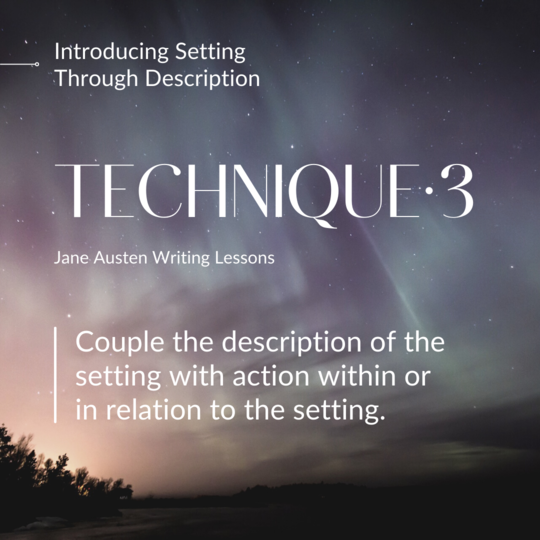
Technique 3: Couple the description of the setting with action within or in relation to the setting.
While description can at times slow or halt the plot, at times they can be paired together. Rather than completely describing a setting and then having action occur within it in, Jane Austen will provide details of the setting as an action occurs.
As Elizabeth encounters Rosings, they are moving, both physically and emotionally, to meet the great Lady Catherine; Mr. Collins is talking—describing the place (speech in itself is a type of action); and we are learning more about the setting and its inhabitants as we physically pass through it:
From the entrance hall, of which Mr. Collins pointed out, with a rapturous air, the fine proportion and finished ornaments, they followed the servants through an antechamber, to the room where Lady Catherine, her daughter, and Mrs. Jenkinson were sitting.
A few pages later, Austen uses the same technique, describing other objects in the space as they are used.
When the gentlemen had joined them, and tea was over, the card tables were placed. Lady Catherine, Sir William, and Mr. and Mrs. Collins sat down to quadrille; and as Miss De Bourgh chose to play at cassino, the two girls had the honour of assisting Mrs. Jenkinson to make up her party.
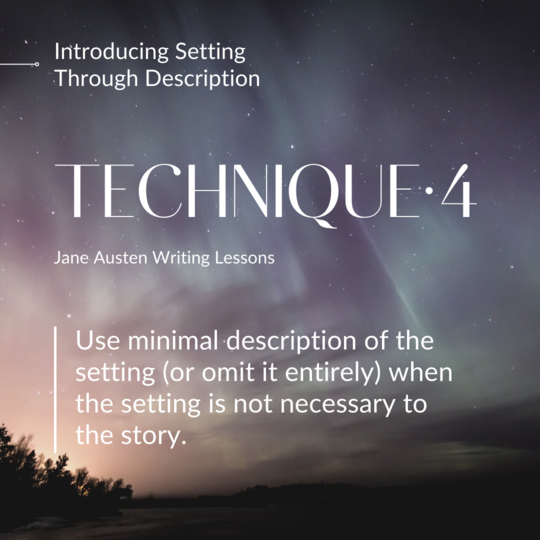
Technique 4: Use minimal description of the setting (or omit it entirely) when the setting is not necessary to the story.
It is the temptation of the writer to describe, in full detail, cool places, buildings, and objects, even when doing so is not absolutely necessary to the story. This is an indulgence which Austen tends to avoid. (Some writing styles like to linger on setting for setting’s sake, and doing so can also be effective, but even if you are writing in one of these styles, there is still a risk of over-indulging in description.)
Later in Pride and Prejudice, Elizabeth takes a trip with her aunt and uncle to Derbyshire, which happens to be where Mr. Darcy lives. Despite this being a sight-seeing trip for Elizabeth, full of interesting towns, landscapes, and historic sights which could easily be a full chapter, and could possibly reveal something about Elizabeth’s character or her relationship with her aunt and uncle, Austen does not provide any description of the setting, and her narrator even comments on the fact that she is not providing description:
It is not the object of this work to give a description of Derbyshire, nor of any of the remarkable places through which their route thither lay; Oxford, Blenheim, Warwick, Kenelworth, Birmingham, &c are sufficiently known. A small part of Derbyshire is all the present concern.
The small part of Derbyshire the narrator focuses on is Lambton, which Mrs. Gardiner has a personal connection to, and which happens to be near Mr. Darcy’s home, Pemberley.
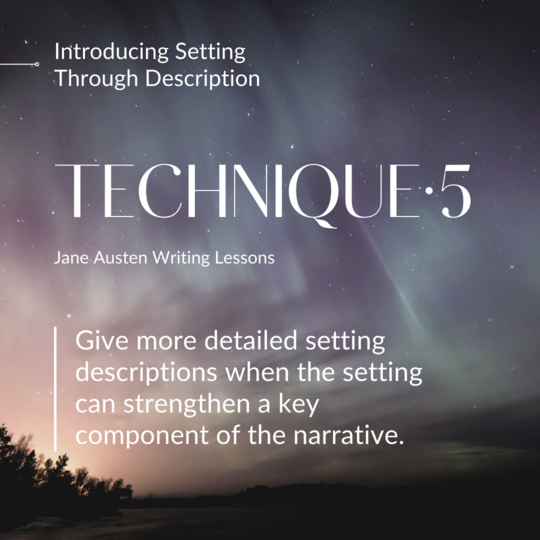
Technique 5: Give more detailed setting descriptions when the setting can strengthen a key component of the narrative.
While at many points in a story description is unnecessary, or is useful only in small portions, at other times detailed description of a setting can add depth to a story, highlight a character’s deep emotions or internal transformation, and prepare the reader for what is to come.
In contrast to the minimal description of the parsonage and Rosings, and the complete lack of description of the rest of the “remarkable places” during the journey to Lambton, Austen provides pages of description about the grounds and interior of Pemberley. Here are the first few paragraphs:
Elizabeth, as they drove along, watched for the first appearance of Pemberley Woods with some perturbation; and when at length they turned in at the lodge, her spirits were in a high flutter.
The park was very large, and contained great variety of ground. They entered it in one of its lowest points, and drove for some time through a beautiful wood, stretching over a wide extent.
Elizabeth’s mind was too full for conversation, but she saw and admired every remarkable spot and point of view. They gradually ascended for half a mile, and then found themselves at the top of a considerable eminence, where the wood ceased, and the eye was instantly caught by Pemberley House, situated on the opposite side of a valley, into which the road with some abruptness wound. It was a large, handsome, stone building, standing well on rising ground, and backed by a ridge of high woody hills;—and in front, a stream of some natural importance was swelled into greater, but without any artificial appearance. Its banks were neither formal, nor falsely adorned. Elizabeth was delighted. She had never seen a place for which nature had done more, or where natural beauty had been so little counteracted by an awkward taste. They were all of them warm in their admiration; and at that moment she felt, that to be mistress of Pemberley might be something!
This level of description is more powerful for having been saved for this moment. Elizabeth’s level of engagement with the setting, as demonstrated by the copious description, shows her attentiveness not just to Pemberley but to its owner, Mr. Darcy. Elizabeth is not just noticing a setting: she is interacting and engaging with it, and it is as she does so that she has the first conscious realization that maybe she should have accepted Mr. Darcy’s proposal.

Exercise 1: Choose one of your favorite authors and examine how they use description to establish setting. What techniques do they use? Are they the same as those used by Jane or are they different? What is the effect of the setting description on the story?
Exercise 2: Write a short scene involving three people walking through a graveyard. Include details about the setting, but do so in a way that reveals things about all three characters and their states of mind.
Exercise 3: Take a story that you have drafted and find places that include (or could include) setting description. Find the following in your manuscript:
- A passage where you could reduce or eliminate description.
- A passage where you could use different details that might give a better overall sense of the setting.
- A passage where setting could be revealed through action.
- A place where the description of the setting could reveal more about the characters and their state of mind.
- A key scene in which more description of the setting could be added to increase the impact of the scene.
Now consider if any of these changes would both match your vision and improve your story; if so, revise!
#29: Use Antagonists as Character Foils
/0 Comments/in Jane Austen Writing Lessons/by Katherine Cowley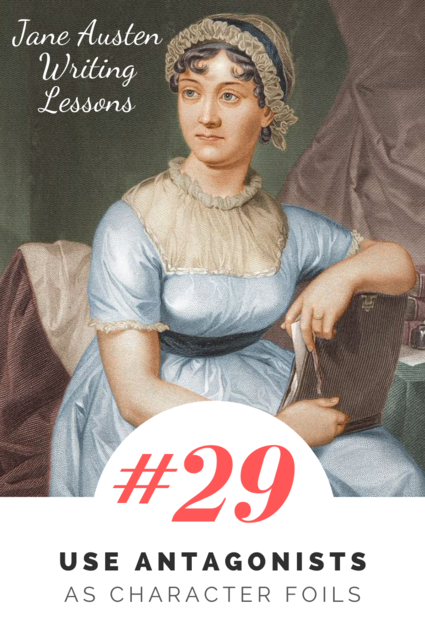
There’s a rather brilliant musical adaptation of Emma that I saw performed live in Chicago (in February 2020, right before everything shut down!).
In one of the songs, “The Recital,” Emma plays the pianoforte and sings at a gathering (while also feeling a little jealous of the attention that Mr. Knightley is paying to Jane Fairfax). And then, Jane moves to the pianoforte and begins to play at about the 1 minute 15 second mark—her playing and singing are clearly superior to Emma’s.
“She plays well, does she not?” says Mr. Knightley.
“Only if you enjoy that polished, extremely gifted sort of talent,” replies Emma.
(You can listen to the song on YouTube—stop at about 2 minutes 39 seconds in, because then it transitions to Harriet’s musings.)
What I love about Paul Gordon’s song is that it brilliantly establishes a contrast between Emma and Jane Fairfax, which is made very directly by having them play the very same song. (To me, this works really well for the musical genre.) It’s a shorthand to establish Jane Fairfax as Emma’s foil.
What is a Character Foil?
A character foil is a character who is set up in direct contrast to another character; their opposing attributes or circumstances are featured, with the purpose of revealing things about character and story.
Having a number of different characteristics is not enough for characters to be foils: all characters should be distinctive in some way, and dozens of characters in the story will have contrasting attributes.
In order to be true foils the characters must have something substantial in common, which both invites comparison between the characters and makes their differences more apparent.
Emma and Jane Fairfax are foils to each other. Not only is Jane Fairfax “exactly Emma’s age,” but they are two of the only gentlemen’s daughters in Highbury, and they both have many accomplishments. Yet Jane Fairfax is actually more accomplished; she applies herself with dedication to things while Emma does not. And Emma is in a position of power, wealth, and security, while Jane has none of these things.
A Foil as Antagonist
Not all character foils are antagonists, but many times they are: two people with conflicting characteristics or approaches to life can make natural antagonists. Tension and conflict easily arise between these characters, and it can be a powerful storytelling technique which raises the stakes, highlights the different sorts of choices that could be made (along with resulting consequences), and sheds light on character motivations.
Whether or not a character foil also serves as an antagonist, important contrasts are demonstrated.
A character foil can serve to demonstrate contrast:
- To the protagonist
- To other characters in the novel
- To the reader
In many novels, the foil demonstrates contrast to one or two of these groups, but in Jane Austen’s Emma, contrasts are demonstrated for all three groups.
Contrast demonstrated to the protagonist:
In the opening line of Emma, we learn that Emma is “handsome, clever, and rich,” and throughout her life she has “very little to distress or vex her.”
Yet the existence and presence of Jane Fairfax does vex Emma. When Jane returns to Highbury to stay with her relatives, this is Emma’s internal reaction:
Emma was sorry;—to have to pay civilities to a person she did not like through three long months!—to be always doing more than she wished, and less than she ought! Why she did not like Jane Fairfax might be a difficult question to answer; Mr. Knightley had once told her it was because she saw in her the really accomplished young woman, which she wanted to be thought herself; and though the accusation had been eagerly refuted at the time, there were moments of self-examination in which her conscience could not quite acquit her. But “she could never get acquainted with her: she did not know how it was, but there was such coldness and reserve—such apparent indifference whether she pleased or not—and then, her aunt was such an eternal talker!—and she was made such a fuss with by every body!—and it had been always imagined that they were to be so intimate—because their ages were the same, every body had supposed they must be so fond of each other.” These were her reasons—she had no better.
Emma knows they are the same age, she knows they should have been friends—she is aware of their similarities, and she constantly attempts to emphasize their differences:
She was, besides, which was the worst of all, so cold, so cautious! There was no getting at her real opinion. Wrapt up in a cloak of politeness, she seemed determined to hazard nothing. She was disgustingly, was suspiciously reserved.
Throughout the story, Jane Fairfax also reveals things to Emma about herself: Emma finds herself worried, and perhaps even jealous, when there seems to be a romantic interest between Mr. Knightley and Jane Fairfax.
Contrast demonstrated to other characters in the novel:
The first time in the novel that Jane Fairfax is referenced is actually by Harriet Smith, in conversation with Emma:
“Do you know Miss Bates’s niece? That is, I know you must have seen her a hundred times—but are you acquainted?”
“Oh! yes; we are always forced to be acquainted whenever she comes to Highbury. By the bye, that is almost enough to put one out of conceit with a niece. Heaven forbid! at least, that I should ever bore people half so much about all the Knightleys together, as she does about Jane Fairfax. One is sick of the very name of Jane Fairfax. Every letter from her is read forty times over; her compliments to all friends go round and round again; and if she does but send her aunt the pattern of a stomacher, or knit a pair of garters for her grandmother, one hears of nothing else for a month. I wish Jane Fairfax very well; but she tires me to death.”
Emma’s verbal treatment of Jane Fairfax should act as a warning to Harriet: Emma is not perfect, her vision can be skewed, her intentions not always kind or correct. But despite seeing Jane Fairfax and Emma placed side by side, Harriet does not notice or heed this warning, and it allows Emma to inflict a fair amount of emotional damage on Harriet.
Other characters see a contrast between Emma and Jane Fairfax and chose sides. It is clear, for instance, that Mrs. Elton does not particularly like Emma. She does take a liking to Jane Fairfax and attempts to take her under her wing. Yet Mrs. Elton’s attentions are not always good for Jane Fairfax, something which Emma feels (and even begins to disagree with) as she watches Mrs. Elton attempt to take away Jane’s limited autonomy.
Contrast demonstrated to the reader:
Even before Jane Fairfax is introduced, it is clear that Emma is not always the best person—she can be unlikeable, interfering, and a bit of an antihero. Setting up a foil for Emma further highlights her failings, negative qualities, and weaknesses.
The foil also helps create a beautiful redemption arc for Emma, because it takes a long time, but Emma does begin to change and improve. Despite their differences and her long-proclaimed dislike of Jane Fairfax, Emma realizes and resolves:
“I ought to have been more her friend.—She will never like me now. I have neglected her too long. But I will shew her greater attention than I have done.”
It is not long before Emma is put to the test. She almost uses her wit against Jane Fairfax, as she is wont to do:
She could have made an inquiry or two, as to the expedition and the expense of the Irish mails;—it was at her tongue’s end—but she abstained. She was quite determined not to utter a word that should hurt Jane Fairfax’s feelings; and they followed the other ladies out of the room, arm in arm, with an appearance of good-will highly becoming to the beauty and grace of each.
Later, Jane is feeling unwell and decides to leave a social event at Donwell Abbey early. At first, Emma tries to do what she thinks would be the most kind and solicitous action—to call a carriage. But ultimately, she allows Jane Fairfax to do what Jane wants, which gives her the autonomy and societal power she is often denied. The following passage begins with Jane speaking:
“I am fatigued; but it is not the sort of fatigue—quick walking will refresh me.—Miss Woodhouse, we all know at times what it is to be wearied in spirits. Mine, I confess, are exhausted. The greatest kindness you can shew me, will be to let me have my own way, and only say that I am gone when it is necessary.”
Emma had not another word to oppose. She saw it all; and entering into her feelings, promoted her quitting the house immediately, and watched her safely off with the zeal of a friend. Her parting look was grateful—and her parting words, “Oh! Miss Woodhouse, the comfort of being sometimes alone!”—seemed to burst from an overcharged heart, and to describe somewhat of the continual endurance to be practised by her, even towards some of those who loved her best.
The contrast between the characters and their evolving relationship creates a powerful story for readers. While Emma and Jane Fairfax never have a complete, total reconciliation, the transformation of their relationship is dramatic.
Wrapping up
Not all character foils need to have this sort of reconciliation. And sometimes, a character foil is used for a character other than the main protagonist. In Pride and Prejudice, Mr. Darcy and Mr. Wickham acts as foils to each other, and while a sort of agreement is reached between them at the end of the novel, it is more of a triumph of Darcy and his principles over Wickham.
Using character foils can be a powerful tool, especially with antagonists, which can create marked contrasts for the protagonist, for other characters, and for the reader.

Exercise 1: Think about one of your favorite character foils from a book or a movie. What do the characters have in common? What is different about these characters? Who notices this contrast, how does this foil effect the plot, and what is the impact of this foil on the reader?
Exercise 2: Take one of your characters who does not have a foil (either from a story you have already written or a character you have brainstormed). Craft a character who could be an effective foil for this character. What would be the advantages of using a foil in your story? What would be the disadvantages?
Exercise 3: Choose a classic fairy tale character, like Belle from Beauty and the Beast. Now create a character foil for this character. The catch: you have to use this random number generator.
Use the random number generator 3 times to choose 3 of the following possible contrasts. Use these three types of contrasts to craft a character foil for the fairy tale character (but also make sure to give the characters enough in common that they are set up as foils).
General categories of possible contrasts:
- Background
- Education
- Personality
- Choices
- Approach to life
- Physical attributes or abilities
- Mental attributes or abilities
- Economic status
- Power/hierarchy
- Gender
- Passive/active
- Strengths/weaknesses
- Wants/needs
- Sympathetic/unsympathetic
Bonus: do the same exercise, but this time use the generated numbers to choose the things that are similar about the characters.
